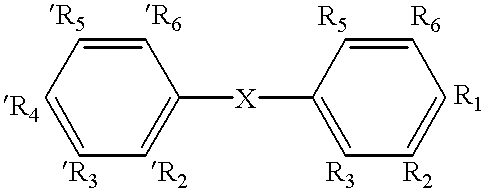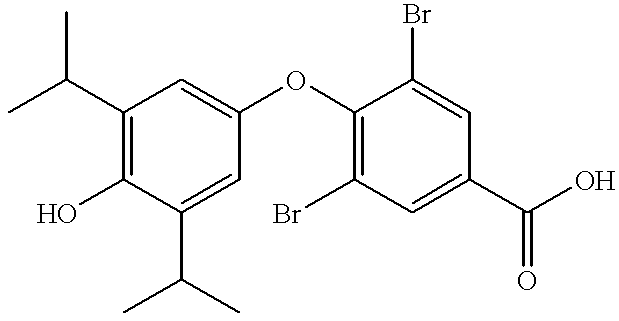Nuclear receptor ligands and ligand binding domains
a technology of ligand binding domain and nuclear receptor, which is applied in the field of nuclear receptor ligands and ligand binding domains, can solve the problems of lack of three-dimensional structural information about the ligand binding domain of the nuclear receptor, thwarting the field of nuclear receptor drug discovery, and absence of thr
- Summary
- Abstract
- Description
- Claims
- Application Information
AI Technical Summary
Problems solved by technology
Method used
Image
Examples
example 1-- synthesis
EXAMPLE 1--SYNTHESIS OF TR LIGANDS
Many TR ligands are known in the art, including T4 (thyroxine), T3, T2 and TS-9. See Jorgensen, Thyroid Hormones and Analogs, in Hormonal Proteins and Peptides, Thyroid Hormones 107-204 (Choh Hao Li ed., 1978), incorporated by reference herein.
The syntheses of several TR ligands are described below.
Synthesis of TS1, TS2, TS3, TS4, TS5
TS1, TS2, TS3, TS4 and TS5 and analogs thereof can all be prepared by simple acylation of the nitrogen atom of any thyronine analog, including T3 (3,5,3'-triiodo-L-thyronine), T4 (thyroxine) and 3,5-diiodothyronine. TS1 and TS2 are synthesized by reacting T3 with Ph.sub.2 CHCO.sub.2 NHS (N-hydroxy succinimide-2,2-diphenylacetate) and C.sub.16 H.sub.33 CO.sub.2 NHS, respectively. TS3 is synthesized by reacting T3 with FMOC-Cl (fluorenylmethyloxycarbonylchloride). TS4 is synthesized by reacting T3 with tBOC.sub.2 O (tBOC anhydride or di-t-butyldicarbonate). TS5, which differs from TS1-4 by having a --H instead of an --I a...
example 2--
RECEPTOR BINDING ASSAYS OF TR LIGANDS
To test the ability of synthesized TR ligands to bind to a thyroid receptor (TR), the binding affinity of a TR ligand for TR is assayed using TR's prepared from rat liver nuclei and 125.sub.I T.sub.3 as described in J. D. Apriletti, J. B. Baxter, and T. N. Lavin, J. Biol. Chem., 263: 9409-9417 (1988). The apparent Kd's are calculated using the method described by Apriletti (1995) and Apriletti (1988). The apparent Kd's are presented in TABLE 3. The apparent Kd's (App.Kd) are determined in the presence of the sample to be assayed, 1 nM [.sup.125 I]T.sub.3, and 50 .mu.g / ml core histones, in buffer E (400 mM KCl, 200 mM potassium phosphate, pH 8.0, 0.5 mM EDTA, 1 mM MgCl.sub.2, 10% glycerol, 1 mM DTT) in a volume of 0.21 ml. After incubation overnight at 4.degree. C., 0.2 ml of the incubation mixture is loaded onto a Quick-Sep Sephadex G-25 column (2.7.times.0.9 cm, 1.7 ml bed volume) equilibrated with buffer E. The excluded peak of protein-bound [....
example 3-- increased
EXAMPLE 3--INCREASED NUCLEAR PROTEIN COACTIVATION BY TR LIGANDS
To test the ability of TR ligands to activate the binding of TR to the nuclear activation protein RIP-140 (a nuclear protein that can bind to nuclear receptors, such as the estrogen receptor), a TR ligand is liganded to TR and then incubated with RIP-140 as described in V. Cavailles, et al., EMBO J., 14(15):3741-3751 (1995), which is incorporated by reference herein. In this assay, 35.sub.s -RIP-140 protein binds to liganded TR but not unliganded TR. Many TR 35.sub.s ligands can activate RIP-140 binding as shown in TABLE 3.
PUM
| Property | Measurement | Unit |
|---|---|---|
| temperatures | aaaaa | aaaaa |
| temperatures | aaaaa | aaaaa |
| crystallization temperatures | aaaaa | aaaaa |
Abstract
Description
Claims
Application Information
 Login to View More
Login to View More - R&D
- Intellectual Property
- Life Sciences
- Materials
- Tech Scout
- Unparalleled Data Quality
- Higher Quality Content
- 60% Fewer Hallucinations
Browse by: Latest US Patents, China's latest patents, Technical Efficacy Thesaurus, Application Domain, Technology Topic, Popular Technical Reports.
© 2025 PatSnap. All rights reserved.Legal|Privacy policy|Modern Slavery Act Transparency Statement|Sitemap|About US| Contact US: help@patsnap.com



